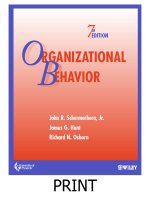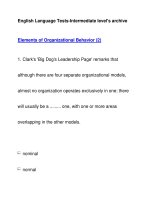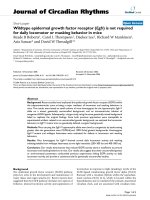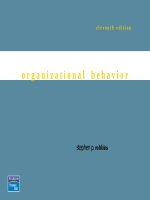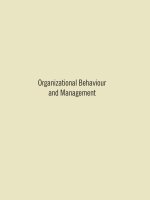Chap1 or organizational behavior.
Bạn đang xem bản rút gọn của tài liệu. Xem và tải ngay bản đầy đủ của tài liệu tại đây (96.6 KB, 48 trang )
Chapter 1 What Is Organizational Behavior?
MULTIPLE CHOICE
Importance of Interpersonal Skills
1.
Over the past two decades, business schools have added required courses on people skills to
many of their curricula. Why have they done this?
a.
to succeed.
Managers no longer need technical skills in subjects such as economics and accounting
b.
There is an increased emphasis in controlling employee behavior in the workplace.
c.
Managers need to understand human behavior if they are to be effective.
d.
These skills enable managers to effectively lead human resources departments.
e.
A manager with good people skills can help create a pleasant workplace.
(c; Moderate; Interpersonal Skills; p. 4) {AACSB: Analytic Skills}
2.
Which of the following is most likely to be a belief held by a successful manager?
a.
Technical knowledge is all that is needed for success.
b.
It is not essential to have sound interpersonal skills.
c.
Technical skills are necessary, but insufficient alone for success.
d.
Effectiveness is not impacted by human behavior.
e.
Technical skills do not influence efficiency.
(c; Easy; Interpersonal Skills; p. 5) {AACSB: Analytic Skills}
What Managers Do
3.
Which of the following would not be considered an organization?
a.
a church
b.
a university
c.
a military unit
d.
all adults in a given community
e.
an elementary school
(d; Moderate; Organization; p. 6) {AACSB: Analytic Skills}
4.
Which of the following is best defined as a consciously coordinated social unit, composed of two
or more people, which functions on a relatively continuous basis to achieve a common goal or set of
goals?
a.
party
b.
unit
c.
team
d.
community
e.
organization
(e; Easy; Organization; p. 6)
5.
Which of the following is least likely to be considered a manager?
a.
an administrator in charge of fund-raising activities in a non-profit organization
b.
a lieutenant leading an infantry platoon
c.
a doctor who acts as head of the physiotherapy department at a public hospital
d.
the mayor of a large city
e.
an IT technician who enables communication between all of a company’s employees
(e; Challenging; Managers; p. 6) {AACSB: Analytic Skills}
6.
Which of the following is not one of the four primary management functions?
a.
controlling
b.
planning
c.
staffing
d.
organizing
e.
leading
(c; Moderate; Management Functions; p. 6) {AACSB: Analytic Skills}
7.
Which of a manager’s primary roles requires the manager to define an organization’s goals,
establish an overall strategy for achieving these goals and develop a comprehensive hierarchy of plans to
integrate and coordinate activities?
a.
controlling
b.
planning
c.
staffing
d.
coordinating
e.
leading
(b; Moderate; Management Functions; p. 6) {AACSB: Analytic Skills}
8.
Determining how tasks are to be grouped is part of which management function?
a.
planning
b.
leading
c.
controlling
d.
organizing
e.
contemplating
(d; Easy; Management Functions; p. 6) {AACSB: Analytic Skills}
9.
Mintzberg concluded that managers perform 10 different, highly interrelated roles. Which of the
following is one of the broad categories into which these roles could be grouped?
a.
intrapersonal
b.
institutional
c.
decisional
d.
affective
e.
reflective
(c; Moderate; Management Roles; p. 7) {AACSB: Analytic Skills}
10.
As a manager, one of Joe’s duties is to present awards to outstanding employees within his
department. Which Mintzberg managerial role is Joe acting in when he does this?
a.
leadership role
b.
liaison role
c.
monitor role
d.
figurehead role
e.
spokesperson role
(d; Challenging; Interpersonal Roles; p. 7) {AACSB: Analytic Skills}
11.
According to Mintzberg, one of management’s interpersonal roles is _____.
a.
spokesperson
b.
leader
c.
negotiator
d.
monitor
e.
devil’s advocate
(b; Moderate; Interpersonal Roles; p. 7) {AACSB: Analytic Skills}
12.
According to Mintzberg, when a manager searches the organization and its environment for
opportunities and initiates projects to bring about change, the manager is acting in which role?
a.
negotiator
b.
entrepreneur
c.
monitor
d.
resource allocator
e.
reflective analyst
(b; Challenging; Decisional Roles; p. 7) {AACSB: Analytic Skills}
13.
Robert Katz identified three essential skills that managers need to have in order to reach their
goals. What are these skills?
a.
technical, decisional and interpersonal
b.
technical, human, and conceptual
c.
interpersonal, informational and decisional
d.
conceptual, communication and networking
e.
human, informational and communication
(b; Moderate; Management Skills; p. 8) {AACSB: Analytic Skills}
14.
A manager is valued by her colleagues for her ability to perform effective break-even analysis on
upcoming ventures. In this case, her colleagues value her for competencies that fall within which of
Katz’s essential management skills categories?
technical
communication
human
conceptual
education
(a; Moderate; Technical Skills; p. 8) {AACSB: Analytic Skills}
15.
According to Katz, technical skills encompass the ability to _____.
a.
analyze and diagnose complex situations
b.
exchange information and control complex situations
c.
apply specialized knowledge or expertise
d.
initiate and oversee complex projects
e.
communicate effectively with others
(c; Challenging; Technical Skills; p. 8)
16.
Which one of the following would not be considered a human skill in Katz’s structure?
a.
decision making.
b.
communicating
c.
resolving conflicts
d.
working as part of a team
e.
listening to others
(a; Easy; Human Skills; p. 8) {AACSB: Analytic Skills}
17.
According to Katz, when managers have the mental ability to analyze and diagnose complex
situations, they possess _____ skills.
technical
leadership
problem-solving
conceptual
reactive
(d; Moderate; Conceptual Skills; p. 8) {AACSB: Analytic Skills}
18.
According to Fred Luthans and his associates, which of the following is considered a part of
traditional management?
a.
disciplining
b.
decision making
c.
exchanging routine information
d.
acquiring resources
e.
investing
(b; Moderate; Traditional Management; p. 8) {AACSB: Analytic Skills}
19.
Which of Luthans’ managerial activities involves socializing, politicking, and interacting with
outsiders?
traditional management
communicating
human resource management
networking
investing
(d; Easy; Networking; p. 9)
20.
How does Luthans define a manager’s success?
a.
by the quantity and quality of their performance
b.
by the satisfaction and commitment of their employees
c.
by the rate and quantity of pay raises
d.
by the speed of their promotion
e.
by their scores on a 360-degree feedback analysis
(d; Moderate; Successful Managerial Activities; p. 9)
21.
According to Luthans’ research, successful managers spent more of their time on _____ than on
any other activity.
traditional management
human resource management
networking
communicating
hiring and firing
(c; Moderate; Networking; p. 9)
22.
What did a study of U.S. managers indicate about those managers who seek information from
colleagues and employees?
a.
They are rapidly promoted.
b.
They are generally more popular.
c.
They are less efficient as leaders.
d.
They are generally given fewer promotions, raises and other rewards.
e.
They are generally more effective managers.
(e; Moderate; Effective Managerial Activities; p. 9) {AACSB: Communication}
EMBED PBrush
23.
The pie charts above show how 5 different managers spent their time. According to Luthans’
research, which manager is most likely to receive more promotions and other rewards associated with
career success?
a.
Manager A
b.
Manager B
c.
Manager C
d.
Manager D
e.
Manager E
(c; Moderate; Successful Managerial Activities; p. 9) {AACSB: Analytic Skills}
24.
While the Functions, Roles, Skills, and Activities approaches to management all differ, they all
recognize that effective and successful managers must develop which of the following?
a.
people skills
b.
technical skills
c.
efficiency
d.
entrepreneurialism
e.
ability to network
(a; Moderate; Manager’s Job; p. 10)
Enter Organizational Behavior
25.
An OB study would be least likely to be used to focus on which of the following problems?
a.
an increase in absenteeism at a certain company
b.
a fall in productivity in one shift of a manufacturing plant
c.
a decrease in sales due to growing foreign competition
d.
an increase in theft by employees at a retail store
e.
excessive turnover in volunteer workers at a non-profit organization
(c; Moderate; Organizational Behavior; p. 10) {AACSB: Analytic Skills}
26.
What are the three primary determinants of behavior that organizational behavior focuses
upon?
a.
profit structure, organizational complexity, job satisfaction
b.
individuals, profit structure, and job satisfaction
c.
individuals, groups, and job satisfaction
d.
groups, structure, and profit structure
e.
individuals, groups, and structure
(e; Challenging; Organizational Behavior; p. 10) {AACSB: Analytic Skills}
27.
______ is a field of study that investigates the impact that individuals, groups, and structure
have on behavior within organizations for the purpose of applying such knowledge toward improving an
organization’s effectiveness.
Organizational development
Human Resources Management
Organizational behavior
People management
Corporate strategy
(c; Easy; Organizational Behavior; p. 10)
28.
Which of the following is not a core topic of organizational behavior?
motivation
attitude development
conflict
resource allocation
work design
(d; Moderate; Organizational Behavior; p. 11) {AACSB: Analytic Skills}
Complementing Intuition with Systematic Study
29.
In order to predict human behavior, it is best to supplement your intuitive opinions with
information derived in what fashion?
a.
common sense
b.
direct observation
c.
systematic inquiry
d.
speculation
e.
organizational theory
(c; Moderate; Systematic Study; p. 11)
30.
Which of the following is a reason that the study of organizational behavior is useful?
a.
Human behavior does not vary a great deal between individuals and situations.
b.
Human behavior is not random.
c.
Human behavior is not consistent.
d.
Human behavior is rarely predictable.
e.
Human behavior is often not sensible.
(b; Easy; Systematic Study; p. 11) {AACSB: Analytic Skills}
31.
What approach involves managers centering their decisions on the best available scientific data?
a.
intuition
b.
organizational behavioral studies
c.
substantive evidence approach
d.
preconceived notions
e.
evidence based management
(e; Easy; Evidence Based Management; p. 11)
32.
What do the fundamental consistencies underlying the behavior of all individuals enable
researchers to do?
a.
observe human behavior
b.
systematize human behavior
c.
research human behavior
d.
predict human behavior
e.
detect human behavior
(d; Moderate; Systematic Study; p. 11)
33.
Analyzing relationships, determining causes and effects, and basing conclusions on scientific
evidence all constitute aspects of _____ study.
a.
organizational
b.
intuitive
c.
theoretical
d.
systematic
e.
case-based
(d; Moderate; Systematic Study; p. 11)
34.
What do the authors of the textbook advise?
a.
disregard your intuition because it’s usually wrong and will lead to incorrect assumptions
b.
use evidence as much as possible to inform your intuition and experience
c.
rely on research since it is almost always right and researchers don’t make mistakes
d.
make predictions of individuals’ behaviors based on others’ actions
e.
don’t trust preconceived notions unless you have substantive evidence to back them up
(b; Moderate; Systematic Study; p. 13)
Disciplines That Contribute to the OB Field
35.
Organizational behavior is constructed from all of the following disciplines except _____.
a.
physics
b.
psychology
c.
anthropology
d.
sociology
e.
social psychology
(a; Easy; Behavioral Sciences; p. 13) {AACSB: Analytic Skills}
36.
Psychology’s major contributions to the field of organizational behavior have been primarily at
what level of analysis?
a.
the level of the group
b.
the level of the individual
c.
the level of the organization
d.
the level of the culture
e.
the level of interacting groups
(b; Moderate; Psychology; p. 13)
37.
Which behavioral science discipline is most focused on understanding individual behavior?
a.
sociology
b.
social psychology
c.
psychology
d.
anthropology
e.
organizational behavior
(c; Easy; Psychology; p. 13)
38.
The science that seeks to measure, explain, and sometimes change the behavior of humans and
other animals is known as _____.
a.
psychiatry
b.
psychology
c.
sociology
d.
political science
e.
organizational behavior
(b; Moderate; Psychology; p. 13) {AACSB: Analytic Skills}
39.
_____ blends concepts from psychology and sociology.
a.
Corporate strategy
b.
Anthropology
c.
Political science.
d.
Social psychology
e.
Archaeology
(d; Easy; Social Psychology; p. 14) {AACSB: Analytic Skills}
40.
The science that focuses on the influence people have on one another is _____.
a.
psychology
b.
anthropology
c.
political science
d.
social psychology
e.
archaeology
(d; Moderate; Social Psychology; p. 14) {AACSB: Analytic Skills}
41.
Group behavior, power, and conflict are central areas of study for _____.
a.
archaeologists
b.
sociologists
c.
anthropologists
d.
social psychologists
e.
operations analysts
(d; Moderate; Social Psychology; p. 14) {AACSB: Analytic Skills}
42.
_____ focuses on the study of people in relation to their social environment.
Psychology
Sociology
Corporate strategy
Political science
Operations management
(b; Moderate; Sociology; p. 15) {AACSB: Analytic Skills}
43.
Significant contributions to OB in the study of group behavior in organizations have been made
by _____.
a.
psychologists
b.
sociologists
c.
anthropologists
d.
political scientists
e.
operations analysts
(b; Moderate; Sociology; p. 15) {AACSB: Analytic Skills}
44.
Which field of study has contributed to OB through its research on organizational culture and
formal organization theory and structure?
a.
psychology
b.
operations management
c.
corporate strategy
d.
political science
e.
sociology
(e; Moderate; Sociology; p. 15) {AACSB: Analytic Skills}
45.
Which of the following fields has most helped us understand differences in fundamental values,
attitudes, and behavior among people in different countries?
a. anthropology
b. psychology
c. political science
d. operations research
e. psycholinguistics
(a; Challenging; Anthropology; p. 15) {AACSB: Analytic Skills}
46.
The subject of organizational culture has been most influenced by which behavioral science
discipline?
a.
anthropology
b.
psychology
c.
social psychology
d.
political science
e.
corporate strategy
(a; Moderate; Anthropology; p. 15) {AACSB: Analytic Skills}
There are Few Absolutes in OB
47.
Which of the following statements best describes the current status of Observational Behavior
concepts?
a.
They are based on universal truths.
b.
They can be used to predict human behavior only if the situation is clearly specified.
c.
There is general consensus among OB researchers and scholars on the simple concepts
that underlie most human behavior.
d.
The cause-effect principles that tend to apply to all situations have been discovered.
e.
Cause and effect relationships for most human behaviors have been isolated.
(b; Easy; Observational Behavior; p. 16) {AACSB: Analytic Skills}
48.
There are _____ simple and universal principles that explain organizational behavior.
a.
an infinity of
b.
absolutely no
c.
a confusing array of
d.
fourteen
e.
few if any
(e; Challenging; Observational Behavior; p. 16)
49.
In order to predict human behavior with any degree of accuracy, what sort of variables must be
taken into account?
a.
global
b.
general
c.
dependent
d.
non-reactive
e.
contingency
(e; Moderate; Contingency Variables; p. 16)
Challenges and Opportunities for OB
50.
_____ is/are the number one reason that business travelers have cut back on their travel.
a.
Lower profits
b.
Shareholder interventions
c.
Greater communications technology
d.
Better accounting principles
e.
Fear of terrorism
(e; Moderate; Responding to Globalization; p. 18)
51.
Which of the following OB topics is not central to managing employees’ fears about terrorism?
a.
emotion
b.
motivation
c.
communication
d.
leadership
e.
work design
(e; Easy; Responding to Globalization; p. 18)
5.
Whereas _____ focuses on differences among people from different countries, _____ addresses
differences among people within given countries.
a.
workforce diversity; globalization
b.
globalization; workforce diversity
c.
culture; diversity
d.
culturization; workforce diversity
e.
psychology; social psychology
(b; Challenging; Globalization and Workforce Diversity; p. 18) {AACSB: Analytic Skills} {AACSB:
Multicultural and Diversity}
53.
_____ is a measure of how organizations are becoming more heterogeneous in terms of gender,
race, and ethnicity.
Globalization
Workforce diversity
Affirmative action
Organizational culture
Operational homogeneity
(b; Easy; Workforce Diversity; p. 18) {AACSB: Multicultural and Diversity}
54.
In what way does current thought on workplace diversity differ from the older “melting-pot”
assumption?
by recognizing that employees don’t set aside their cultural values, lifestyle preferences, and differences
when they come to work
by realizing that people from diverse backgrounds will automatically begin to integrate into the larger
workplace and community over time
by taking active steps to minimize the effect of cultural values and lifestyle preference within the
workplace
by openly seeking a heterogeneous workplace and avoiding homogeneity wherever possible
by using techniques such as structured workshops to show employees that behavior that is perfectly
valid within their community may not be valid in the context of the workplace
(a; Moderate; Workforce Diversity; p. 19) {AACSB: Multicultural and Diversity}
55.
In 2003, which group made up 46.7 percent of the U.S. labor force?
a.
people over the age of 65
b.
Latino/as
c.
African-Americans
d.
men
e.
women
(e; Moderate; Workforce Diversity; p. 20) {AACSB: Multicultural and Diversity}
56.
What is the probable consequence of the fact that women significantly outnumber men on U.S.
college campuses?
a.
Eventual parity in the number of men and women in the workforce.
b.
An increase in the number of technical positions filled by women.
c.
An increase in competition between men for professional and managerial jobs
d.
A steady increase in the number of technical, professional, and managerial positions
e.
women.
A decrease in the competition for jobs in positions that have traditionally been filled by
(b; Moderate; Workforce Diversity; p. 20) {AACSB: Multicultural and Diversity}
57.
Increasingly, we can expect that women will be hired into _____ positions.
a.
menial
b.
traditionally female
c.
medical (nurse)
d.
socially-oriented
e.
professional
(e; Easy; Workforce Diversity; p. 20) {AACSB: Multicultural and Diversity}
58.
What was the most significant change in the U.S. labor force during the last half of the twentieth
century?
a.
substantial decreases in the number of workers who are under 55
b.
increases in the percentage of U.S. citizens of Hispanic origin
c.
increasing numbers of African-Americans at all levels within the workforce
d.
the steady increase in the percentage of workers that are men
e. the rapid increase in the percentage of workers that are women
(e; Challenging; Workforce Diversity; p. 20) {AACSB: Multicultural and Diversity}
59.
Which of the following statements is not an implication of increased workplace diversity?
Managers should recognize differences between workers.
Diversity training should be provided.
Employee benefits should be revamped to accommodate the different needs of different employees.
It is critical that all workers be treated alike.
Innovation and creativity in organizations is likely to increase.
(d; Challenging; Workforce Diversity; pp. 20-21) {AACSB: Multicultural and Diversity}
60.
According to the textbook, when diversity is not managed properly, there is a potential for
_____.
a.
higher creativity
b.
communication benefits
c.
labor cost inequities
d.
increased competitiveness
e.
higher turnover
(e; Moderate; Workforce Diversity; p. 21) {AACSB: Multicultural and Diversity}
61.
According to management guru Tom Peters, almost all quality improvement comes from _____
of design, manufacturing, layout, processes, and procedures.
a.
modification
b.
stratification
c.
integration
d.
separation
e.
simplification
(e; Moderate; Quality Improvement; p. 21)
62.
Today’s managers understand that the success of any effort at improving quality and productivity
must include _____.
a.
process reengineering
b.
quality management programs
c.
customer service improvements
d.
employees
e.
manufacturing simplification
(d; Moderate; Quality Improvement; p. 21)
63.
The majority of employees today in developed countries work in _____.
manufacturing jobs
service jobs
MNCs
government agencies
the military
(b; Moderate; Customer Service; p. 21)
64.
Approximately _____ % of the U.S. labor force is employed in service industries.
a.
10
b.
25
c.
40
d.
60
e.
80
(e; Challenging; Customer Service; p. 21)
65.
Service industry jobs include all of the following except _____.
a.
fast good counter worker
b.
sales clerk
c.
waiter
d.
nurse
e.
production line worker
(e; Easy; p. Customer Service; p. 21) {AACSB: Analytic Skills}
66.
Which of the following factors makes it imperative that organizations be fast and flexible?
a.
temporariness
b.
corporate excess
c.
truncated capacity
d.
advances in corporate strategy
e.
globalization
(e; Moderate; Temporariness; p. 23)
67.
Given the climate of “temporariness” in modern organizations, employees must _____.
a.
continually update their knowledge and skills
b.
be prepared to stay in the same position for longer periods of time
c.
make closer connections to their peers
d.
foster friendship within the work environment
e.
limit their mobility if they hope to compete
(a; Easy; Temporariness; p. 23)
68.
Which of the following is the major challenge to managers in a fully networked organization?
a.
and the like
eliminating the need for paper communication by relying entirely on email, file transfers
b.
retaining team members who can easily move to another employer when demand for
their services changes
c.
d.
Internet
managing contract and temporary workers
maintaining a “virtual office” through the use of computers, interoffice networks and the
e. managing people who work together but are geographically separated
(e; Easy; Networked Organizations; pp. 23-24)
69.
_____ allow(s) people to communicate and work together even though they may be thousands
of miles apart.
a.
Flexible cubicles
b.
Stratified work environments
c.
Cyber-empowerment machines
d.
widespread use of computers
e.
Networked organizations
(e; Easy; Networked Organizations; p. 23)
70.
Which of the following has not contributed to blurring the lines between employees’ work life
and personal life?
the creation of global organizations
communications technology allowing employees to work any time and from any place
organizations asking employees to put in longer hours
creation of flexible teams
the increase in dual career households
(d; Moderate; Balance Work-Life Conflicts; p. 24) {AACSB: Analytic Skills}
71.
What growth area in OB research concerns how organizations develop human strengths, foster
vitality and resilience, and unlock potential?
a.
positive organizational scholarship
